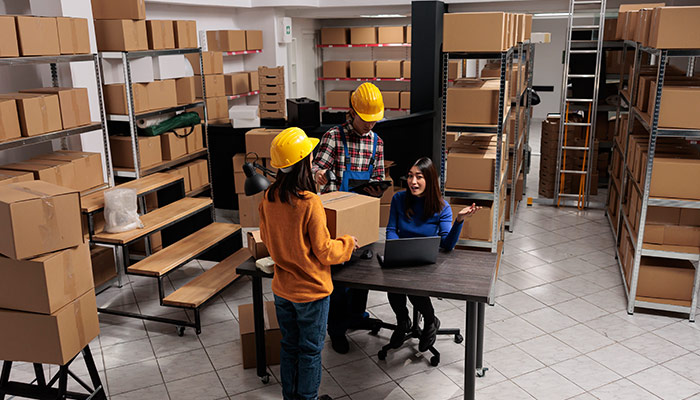Choosing the right unit size is crucial when storing items for a short or long time. Whether you’re moving, decluttering, or need extra space for seasonal items, understanding the available storage unit sizes will help you select the best fit.
Learn more: How Much Do Storage Units Cost?
Let’s explore how to determine “how big of a storage unit I need” and “how much storage space I need” based on your requirements.
Importance of Selecting the Right Storage Unit Size

Selecting the right size can save you money, time, and space. If you choose a unit that’s too small, you risk overcrowding and potential damage to your items.
On the other hand, a unit too large may leave you paying for space you don’t use.
Learn more: Top 10 Creepiest Self-Storage Units in Movies and TV
By using a storage size calculator or reviewing a storage unit space guide, you can make a more informed decision.
5 Factors to Consider When Choosing a Storage Unit Size

- The Volume of Items: Calculate how much storage space you need by assessing the total number of items and their bulkiness.
- Furniture and Appliances: Larger items like couches, beds, or refrigerators will determine the size of your unit.
- Duration of Storage: Long-term storage may require more careful planning for item access.
- Type of Items: Fragile or valuable items may require additional space for protective padding.
- Future Needs: Consider whether you will need extra space for future storage.
Learn more: These NYC Storage Units Cost More Than An Apartment!
Common Storage Unit Sizes and What Fits

When you ask yourself, “What size storage unit do I need,” it’s helpful to know the typical sizes available. Here are the most common storage unit sizes and what can fit inside them:
Learn more: Forbes Awards Clutter.com 4.6 Stars for Revolutionizing Home Storage Solutions
- 5×5 Unit: Roughly the size of a small closet, ideal for storing small furniture, boxes, or seasonal items. Great for students or storing decorations.
- 5×10 Unit: This size can fit the contents of a small studio apartment, including a mattress, dresser, and a few boxes.
- 10×10 Unit: Perfect for a one-bedroom apartment’s worth of furniture, including larger items like couches or refrigerators.
- 10×15 Unit: Ideal for storing the contents of a two-bedroom apartment, large appliances, or bulky items.
- 10×20 or Larger Units: These units can hold the contents of a full-sized house, including furniture, appliances, and even vehicles.
Understanding “different storage unit sizes” can help you find the best storage unit size for moving or other needs.
How to Estimate the Right Size

You can use a storage size calculator to get a better estimate of the space you need. These tools allow you to input your items, and they will suggest the right unit size for you. Alternatively, create a rough estimate by considering how your belongings would fit into a room.
Learn more: Renting a Storage Container: 15 Things You Need to Know
Tips for Maximizing Space in Your Storage Unit
- Disassemble Furniture: Break down larger furniture pieces to make better use of the vertical and horizontal space.
- Use Uniform Boxes: Stackable, same-sized boxes maximize floor-to-ceiling storage.
- Utilize Vertical Space: Make use of shelves or stack items safely to use every inch of the unit.
Size Up or Down When?
Sometimes, it will be better to size up or down. If you’re still adding more items later on, then sizing up would be a good decision.
For minimal and short-term storage, sizing down will save you costs.
Storage size-based cost considerations

Because larger units are more expensive, it is of extreme importance to get the balance right between cost and the amount of space you’ll require.
Learn more: 21 Outdoor Shed Organization & Storage Ideas to Help You Declutter
Keep in mind any items you already have and even items you think you might want stored someday. Then, you’ll choose the correct size from the very start instead of spending extra to get an upgrade.
Maximize Your Space—Get Started with Our Storage Services Today!
Conclusion
Of course, the best storage unit size for a move would depend on your specific needs. You may use an online space guide or even a storage unit size calculator to make a more informed decision. Measure your needs, forecast for the future, and choose according to your expectations with the aim of achieving the best value for your storage solution.
FAQs for Storage Unit Sizes: What Size Storage Unit Do I Need?
How does one determine the size of a storage unit?
Answer: Determine the right size of storage unit by measuring your furniture and thinking about how much space you will require for beds, sofas, tables, and the like. A 10×10 unit can typically fit one one-bedroom apartment but go with what the storage facility recommends for your items.
How much is 10×10 stored compared to a one-bedroom apartment?
Answer: A 10×10 storage unit is approximately able to hold a bedroom apartment’s contents, including a bed, sofa, kitchen appliances, and boxes. Depending on how well things are packed, of course.
How many square feet is the minimum to accommodate storing gear like bicycles, a grill, and lawnmowers?
Answer: Due to the amount of equipment, one typically needs a five-by-ten unit or larger. Bicycles, grills, and lawnmowers can easily fit into a smaller unit like 5×10; however, if you have additional outdoor gear, then you will require a 10×10.
Are the sizes of storage units uniform between locations, or do they vary?
Answer: Although many facilities offer commonly sized units 5×5, 10×10, and 10×20, unit sizes will vary at a facility depending on location. Contact the facility directly to determine whether there are units available and make a choice that best fits your needs.
Can I upgrade to a larger storage unit if I realize I need additional space later?
The majority of storage facilities allow you to upgrade to a bigger unit if you find yourself holding more possessions in your unit than anticipated. It is always a good idea to know the policy at the facility beforehand so that everything goes as smoothly as possible when you need more space.








